UNITED STATES
SECURITIES AND EXCHANGE COMMISSION
Washington, D.C. 20549
FORM N-CSR
CERTIFIED SHAREHOLDER REPORT OF
REGISTERED
MANAGEMENT INVESTMENT COMPANIES
Investment Company Act File Number: 811-02958
| T. Rowe Price International Funds, Inc. |
|
|
| (Exact name of registrant as specified in charter) |
| 100 East Pratt Street, Baltimore, MD 21202 |
|
|
| (Address of principal executive offices) |
| David Oestreicher |
| 100 East Pratt Street, Baltimore, MD 21202 |
|
|
| (Name and address of agent for service) |
Registrant’s telephone number, including area
code: (410) 345-2000
Date of fiscal year end: December 31
Date of reporting period: June 30, 2017
Item 1. Report to Shareholders
 |
|
Global
High Income Bond Fund |
June 30,
2017 |
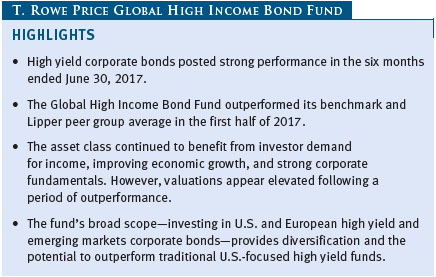
The views and opinions in this report were current as of June 30, 2017. They are not guarantees of performance or investment results and should not be taken as investment advice. Investment decisions reflect a variety of factors, and the managers reserve the right to change their views about individual stocks, sectors, and the markets at any time. As a result, the views expressed should not be relied upon as a forecast of the fund’s future investment intent. The report is certified under the Sarbanes-Oxley Act, which requires mutual funds and other public companies to affirm that, to the best of their knowledge, the information in their financial reports is fairly and accurately stated in all material respects.
REPORTS ON THE WEB
Sign up for our Email Program, and you can begin to receive updated fund reports and prospectuses online rather than through the mail. Log in to your account at troweprice.com for more information.
Manager’s Letter
Fellow Shareholders
High yield bonds rallied amid positive market conditions, as oil and commodity prices stabilized above their 2016 lows and provided a favorable tailwind for the asset class. In the past six months, multiple sectors exhibited leadership, generating gains and capital appreciation. Your fund posted strong returns and maintained broad diversification without taking undue credit risk.
PORTFOLIO PERFORMANCE
The Global High Income Bond Fund returned 5.07% in the six-month period ended June 30, 2017. Our results outperformed the Lipper peer group of similarly managed funds and the benchmark, the Bank of America (BofA) Merrill Lynch Global High Yield Index Hedged to USD, for the past six months. The portfolio’s performance versus its benchmark benefited from credit selection, especially in the U.S., and our overweight allocation to emerging markets. Our underweight in Europe detracted, however.
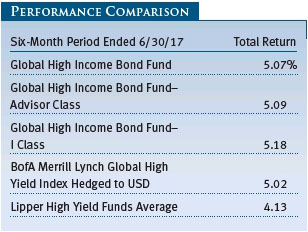
Over the six-month reporting period, the portfolio’s net asset value gained $0.21 and dividends per share totaled $0.30. Capital appreciation has been a significant factor in the fund’s total return. (Results for the Advisor and I Class shares varied, reflecting their different fee structures, cash flows, and other factors.) The fund’s focus is primarily on generating above-average income and, secondarily, on capital appreciation; the 30-day SEC yield at the end of the reporting period was 4.94%, slightly lower than its 5.16% yield six months ago.
The fund is managed with an awareness of its benchmark, but our concentrated approach implies that significant deviations from the BofA index can and will occur. In addition, our active management allows for the flexibility to adjust various allocations depending on changing market conditions and opportunities. At the end of the reporting period, we held a below-benchmark allocation in European high yield (21% of assets), a slight underweight allocation in North American high yield (53%), and an overweight allocation in emerging markets bonds. The portfolio is broadly diversified across industries, countries, and regions. We currently hold bonds from approximately two dozen countries.
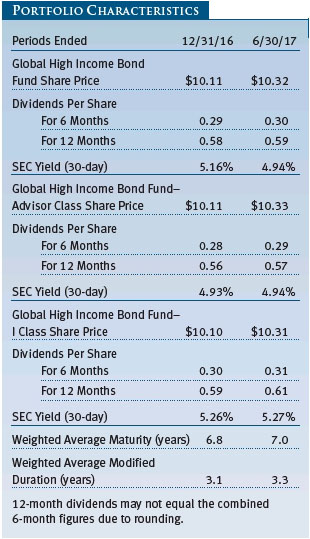
A substantial portion of our North American holdings are in bank loans, the portfolio’s largest non-benchmark allocation. Loans accounted for 9% of the portfolio at the end of the reporting period. We view loans as a proxy for BB rated bonds. Their senior secured status and short-duration characteristics typically provide stability. (Duration is a measure of a portfolio’s sensitivity to interest rate fluctuations.) However, our defensive allocation in loans detracted from relative returns as the high yield bond market outpaced the loan market. As an offset, security selection within our BB rated bond holdings and the underweight allocation to that credit quality segment generated strong absolute and relative performance.
GLOBAL MARKET ENVIRONMENT
Despite a downturn near the end of the reporting period, stabilization in energy and commodity prices above their lows in 2016 supported a tightening of credit spreads across the global high yield bond market. This was particularly true in the U.S. high yield market. (Credit spreads measure the additional yield above that of a comparable-maturity Treasury security that investors demand for holding a bond with credit risk.) Commodity-related sectors compose a smaller portion of the European high yield bond market than in North America and emerging markets.
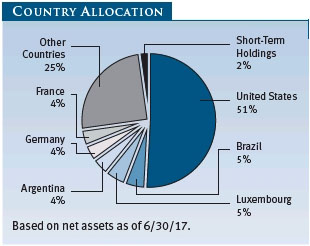
Citing an improving labor market and rising inflation, the Fed raised interest rates by 25 basis points in March and June. The Bank of England held rates steady through the reporting period as the timing and mechanics of the Brexit process remained uncertain. The European Central Bank (ECB) kept its benchmark lending rate at 0.0% and maintained its aggressive bond purchases. However, toward the end of the reporting period, global developed market central banks seemed to strike a more hawkish stance, likely as a result of the sustained period of positive growth following China’s domestic stimulus in early 2016. This led market participants to anticipate that the ECB could begin to scale back its accommodative policies later in the year or early next year. Credit spreads for global investment-grade corporates narrowed, but not as dramatically as in the high yield market.
PORTFOLIO REVIEW
As shown in the Quality Diversification table, slightly less than 87% of the Global High Income Bond Fund is invested in split B and higher rated bonds (including short-term holdings). Of our positions in the CCC rated and below category, about half are U.S.-based where we are comfortable with the risk/reward trade-off, and bankruptcy processes are established. First and foremost, the portfolio’s construction is rooted in bottom-up security selection. However, as we look across the three broad regions where we invest, certain themes emerge, including those associated with sector and economic growth prospects that shape our country and regional allocations. All of our non-U.S. holdings are hedged back to the U.S. dollar to neutralize the impact of currency fluctuations. The fund’s exposure to currency forward contracts detracted from absolute performance, but nondollar bond exposure contributed during the reporting period. Overall, the currency impacts of both positions cancel each other out as we aim to have the value add sourced from credit selection.
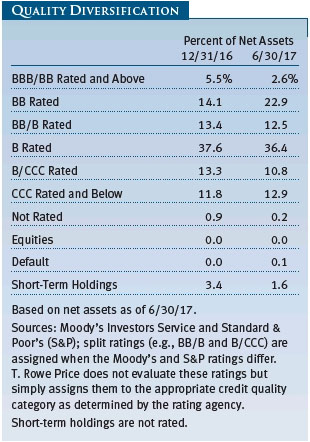
Emerging Markets
For the six-month period, credit selection in emerging markets
and our overweight allocation drove absolute (7%) and relative performance
contributions. Security selection, particularly in Argentina, benefited from a
combination of micro and macro factors. The Argentine government implemented
measures to anchor inflation and instituted labor and capital account reforms
that attracted outside funds into the country,
allowing the companies in which we are invested to lower their cost of capital.
Several of our best performers were financial services firms, including
Banco Macro and Banco Galicia. We also benefited from solid gains in MercadoLibre, which
operates a business similar to Amazon or eBay in Argentina. As the result of
collaboration with our equity colleagues, we owned a MercadoLibre convertible
bond that doubled in value. (Please refer to the fund’s portfolio of investments
for a complete list of holdings and the amount each represents in the
portfolio.)
Petrobras International (Brazil), which benefited from deleveraging and credit spread compression, generated a solid contribution. However, we reduced our exposure during the first quarter ahead of the volatility associated with the corruption probe involving Brazil’s president and locked in gains. In other emerging markets, we established a position in VakifBank, a Turkish bank, on weakness after a period of volatility associated with the 2016 attempted coup. VimpelCom, the Russian telecommunications conglomerate, continued to perform well. Our two bonds represent a meaningful combined position, and it was a top contributor. Within the emerging markets bond universe, we favor B and BB rated issuance and held almost no CCC rated exposure.
Developed Europe
The fund’s European high yield holdings posted about a 5% gain
but lagged the benchmark’s results. The bulk of our underperformance was due to
one holding: Agrokor, a Croatia-based food and soft drink retailer. A lack of
liquidity caused severe bond price declines, and the restructuring process was
initiated. We significantly reduced our Agrokor position prior to the
restructuring process. Security selection in the UK also detracted. The
portfolio was positioned defensively due to potential Brexit volatility that the
market largely ignored. Although we have maintained conservative positioning
across the eurozone, credit selection in France, Luxembourg, and Germany
produced strong absolute and relative returns. French financial holdings
Societe Generale, BNP Paribas, and Credit Agricole were solid performers. The high yield team worked with our
investment-grade analysts and decided to invest in the high yield subordinated
debt of these investment-grade banks.
Financial holdings were the fund’s best relative performance contributors and second best on an absolute-performance basis in the first half of the year. We have invested in an eclectic mix of large, well-capitalized institutions at attractive entry levels, and they have appreciated nicely. Building financials into our second-largest industry allocation (behind energy) reflects the collaboration and solid research efforts across our U.S., emerging markets, and European analyst teams.
North America
The North American sleeve of the portfolio generated more than
a 5% return in the first half of the year and outperformed versus the benchmark
due to security selection. In our view, valuations in the U.S. high yield market
are becoming somewhat extended, and we have systematically rotated the portfolio
into higher-quality U.S. holdings. Of the CCC rated issues we hold, most of it
is in U.S.-based securities. However, many of them yield significantly less than
those in the benchmark, indicating that we are positioned more conservatively
than our benchmark. We are focusing on bonds poised for an upgrade.
The fund’s U.S. exposure also includes bank loans, which accounted for 9% of the portfolio at midyear. The floating rate feature of bank loans decreases interest rate risk, another benefit should interest rates rise. However, in the first half of the year, bank loans lagged high yield bonds and hurt relative performance. We like bank loans for their defensive characteristics and because most of the bank loan market will enjoy rising coupons if interest rates continue to rise.
OUTLOOK
Credit spreads in the global high yield bond market have tightened considerably. With that in mind, we intend to remain focused on investments in the higher-quality tiers of our market, especially in emerging markets and the commodity-related segments. We believe that emerging markets corporate default rates peaked last year and should decline for the next 18 months. Although emerging markets corporate bond yields have declined, we have been unwilling to chase higher-yielding, higher-risk issuance without supportive fundamentals. We have been systematically upgrading the quality of our holdings—approximately 70% of the fund’s emerging markets exposure was invested in BB rated securities at the end of the reporting period.
In Europe, the fundamentals in the high yield market appear sound and volatility has remained low, which has contributed to credit spread compression. The market responded favorably to the French election earlier this year and could also have a benign reaction to upcoming German elections. The European high yield market is positioned to perform well compared with other fixed income assets given the improving economic environment and the relatively short duration profile of the asset class. If volatility picks up, we believe it is likely to stem from political or macro-related factors rather than a deterioration of credit fundamentals in the European high yield market. Given this backdrop, we intend to remain selective and disciplined in our credit selection.
U.S. high yield bonds appear well positioned from a yield and duration perspective relative to many other fixed income sectors. A relatively low duration profile and the higher income of the asset class are attractive in this environment. Steady economic growth and favorable U.S. employment trends are supportive of high yield issuers, which are typically more sensitive to macroeconomic factors than investment-grade segments. Solid corporate fundamentals based on strong earnings and ready access to capital mean that the default rate will likely remain low. However, valuations are historically rich. While our credit analysts struggle to find value within the market, idiosyncratic opportunities do exist, particularly in areas related to merger and acquisition activity and during periods of market volatility.
Enthusiasm tied to the new administration in Washington, D.C., has been priced in, although fiscal stimulus and additional campaign platform policies are proving difficult to implement. Beyond the U.S., central bank policy changes also bring a considerable level of uncertainty. Nevertheless, the already extended economic and credit cycles could stretch further.
As always, our goal is to deliver high current income and attractive total returns over time while seeking to cushion the volatility inherent in this market. We believe that a truly globally diversified portfolio offers a compelling investment opportunity in the high yield bond market. Our team maintains a commitment to credit research and risk-conscious investing that has led to favorable returns for our investors over various market cycles.
Thank you for your confidence in us and for investing with T. Rowe Price.
Respectfully submitted,

Mark J. Vaselkiv
Cochairman of the fund’s Investment Advisory Committee

Michael Della Vedova
Cochairman of the fund’s Investment Advisory Committee
July 19, 2017
The committee chairmen have day-to-day responsibility for managing the portfolio and work with committee members in developing and executing the fund’s investment program.
RISK OF INTERNATIONAL BOND INVESTING
Funds that invest overseas generally carry more risk than funds that invest strictly in U.S. assets. Investments in emerging markets are subject to abrupt and severe price declines and should be regarded as speculative. The economic and political structures of developing nations, in most cases, do not compare favorably with the U.S. or other developed countries in terms of wealth and stability, and their financial markets often lack liquidity. Some countries also have legacies of hyperinflation, currency devaluations, and governmental interference in markets.
Bonds are also subject to interest rate risk, the decline in bond prices that usually accompanies a rise in interest rates, and credit risk, the chance that any fund holding could have its credit rating downgraded or that a bond issuer will default (fail to make timely payments of interest or principal), potentially reducing the fund’s income level and share price.
We would like to remind shareholders about some fundamental changes that have occurred in the fixed income markets in recent years. The markets have been particularly volatile over the past year as investors began to consider the ramifications of a potential rise in interest rates. The volatility has highlighted the importance of sound risk management.
Bond fund assets have grown substantially over the past three decades, with much of the growth taking place since 2008. This has been beneficial in many ways, but like all positive events, it has side effects as well. The prospect of rising interest rates triggers concerns that some investors could change course and redeploy their assets into other financial markets. Net outflows during periods of rising rates are not new; indeed, such was the case in 1994 and 2000 when rates turned up. The market was considerably smaller than it is today, however.
Because of this evolving environment, T. Rowe Price is taking steps to ensure that our funds function smoothly during transitional periods as the Fed implements policy changes that are likely to affect the direction of interest rates. These measures include assessing the liquidity of our portfolios, conducting stress tests that take various market scenarios under consideration, and taking other steps to ensure successful implementation of our investment strategy. We want to inform our shareholders that we are aware of the changing market environment and are monitoring it closely.
GLOSSARY
BofA Merrill Lynch Global High Yield Index Hedged to USD: The Bank of America Merrill Lynch index tracks the performance of global below investment-grade corporate bonds and excludes the effects of currency fluctuation versus the U.S. dollar.
Duration: The average time (expressed in years) needed for an investor to receive the present value of the future cash flows on a fixed income investment. It is used to measure a bond’s or bond fund’s sensitivity to interest rate changes. For example, a fund with a three-year duration would fall about 3% in price in response to a one-percentage-point increase in interest rates, and vice versa. Modified duration provides a more accurate estimate of the fund’s price sensitivity based solely on changes in real interest rates.
Federal funds rate (or target rate): The interest rate charged on overnight loans of reserves by one financial institution to another in the United States. The Federal Reserve sets a target federal funds rate to affect the direction of interest rates.
SEC yield (30-day): A method of calculating a fund’s yield that assumes all portfolio securities are held until maturity. Yield will vary and is not guaranteed.
Weighted average maturity: A measure of a fund’s interest rate sensitivity. In general, the longer the average maturity, the greater the fund’s sensitivity to interest rate changes. The weighted average maturity may take into account the interest rate readjustment dates for certain securities.

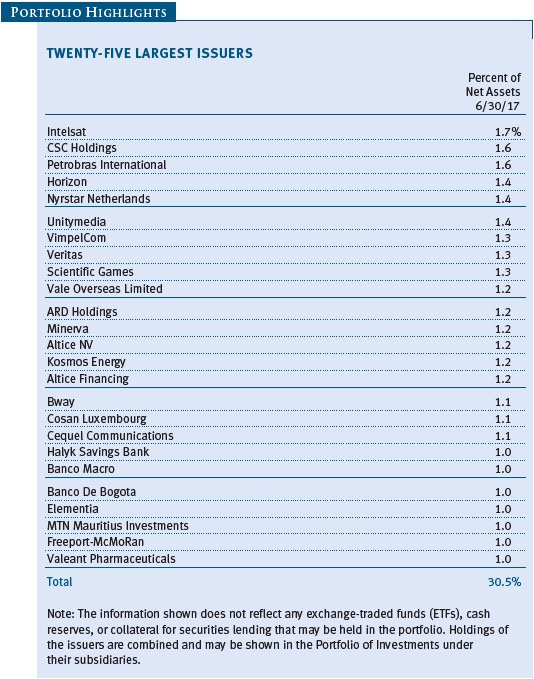
Performance and Expenses
| Growth of $10,000 |
This chart shows the value of a hypothetical $10,000 investment in the fund over the past 10 fiscal year periods or since inception (for funds lacking 10-year records). The result is compared with benchmarks, which may include a broad-based market index and a peer group average or index. Market indexes do not include expenses, which are deducted from fund returns as well as mutual fund averages and indexes.
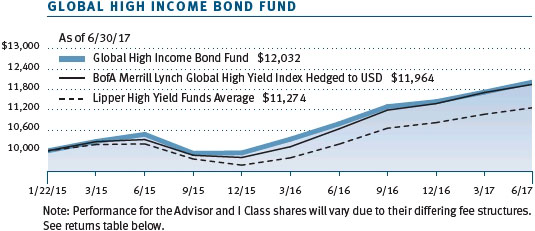
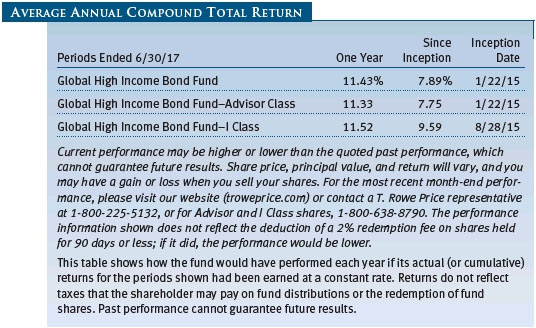

| Fund Expense Example |
As a mutual fund shareholder, you may incur two types of costs: (1) transaction costs, such as redemption fees or sales loads, and (2) ongoing costs, including management fees, distribution and service (12b-1) fees, and other fund expenses. The following example is intended to help you understand your ongoing costs (in dollars) of investing in the fund and to compare these costs with the ongoing costs of investing in other mutual funds. The example is based on an investment of $1,000 invested at the beginning of the most recent six-month period and held for the entire period.
Please note that the fund has three share classes: The original share class (Investor Class) charges no distribution and service (12b-1) fee, Advisor Class shares are offered only through unaffiliated brokers and other financial intermediaries and charge a 0.25% 12b-1 fee, and I Class shares are available to institutionally oriented clients and impose no 12b-1 or administrative fee payment. Each share class is presented separately in the table.
Actual Expenses
The first line of the following table (Actual) provides
information about actual account values and expenses based on the fund’s actual
returns. You may use the information on this line, together with your account
balance, to estimate the expenses that you paid over the period. Simply divide
your account value by $1,000 (for example, an $8,600 account value divided by
$1,000 = 8.6), then multiply the result by the number on the first line under
the heading “Expenses Paid During Period” to estimate the expenses you paid on
your account during this period.
Hypothetical Example for Comparison
Purposes
The information on the second
line of the table (Hypothetical) is based on hypothetical account values and
expenses derived from the fund’s actual expense ratio and an assumed 5% per year
rate of return before expenses (not the fund’s actual return). You may compare
the ongoing costs of investing in the fund with other funds by contrasting this
5% hypothetical example and the 5% hypothetical examples that appear in the
shareholder reports of the other funds. The hypothetical account values and
expenses may not be used to estimate the actual ending account balance or
expenses you paid for the period.
Note: T. Rowe Price charges an annual account service fee of $20, generally for accounts with less than $10,000. The fee is waived for any investor whose T. Rowe Price mutual fund accounts total $50,000 or more; accounts electing to receive electronic delivery of account statements, transaction confirmations, prospectuses, and shareholder reports; or accounts of an investor who is a T. Rowe Price Personal Services or Enhanced Personal Services client (enrollment in these programs generally requires T. Rowe Price assets of at least $250,000). This fee is not included in the accompanying table. If you are subject to the fee, keep it in mind when you are estimating the ongoing expenses of investing in the fund and when comparing the expenses of this fund with other funds.
You should also be aware that the expenses shown in the table highlight only your ongoing costs and do not reflect any transaction costs, such as redemption fees or sales loads. Therefore, the second line of the table is useful in comparing ongoing costs only and will not help you determine the relative total costs of owning different funds. To the extent a fund charges transaction costs, however, the total cost of owning that fund is higher.

Unaudited

The accompanying notes are an integral part of these financial statements.
Unaudited

The accompanying notes are an integral part of these financial statements.
Unaudited
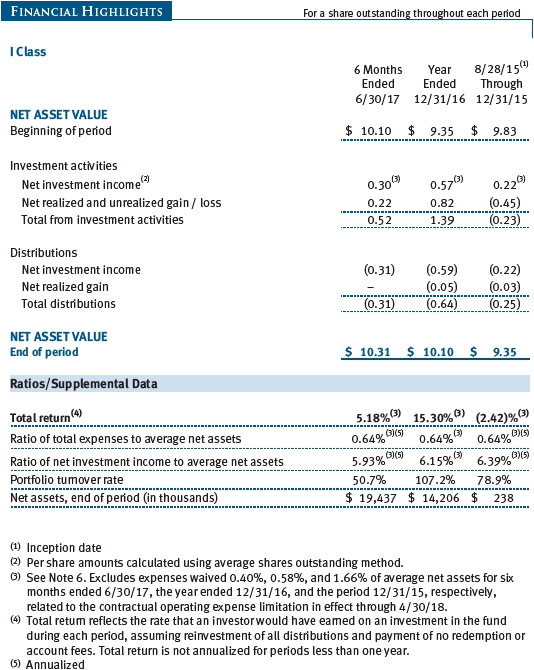
The accompanying notes are an integral part of these financial statements.
Unaudited
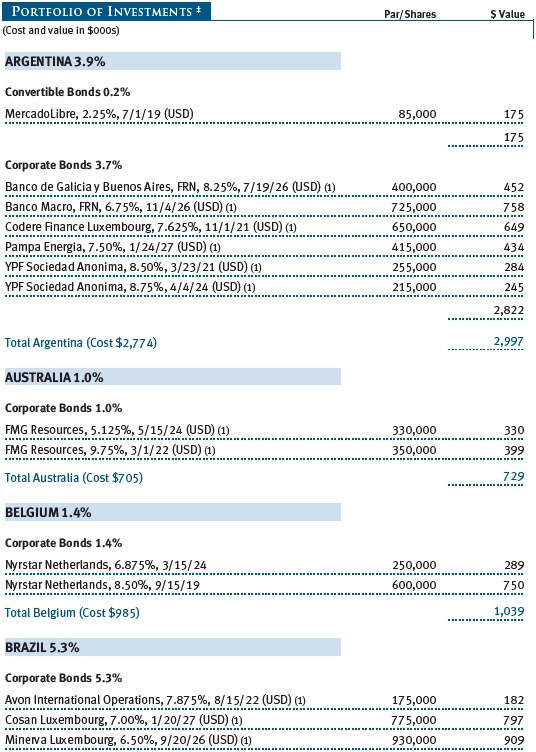
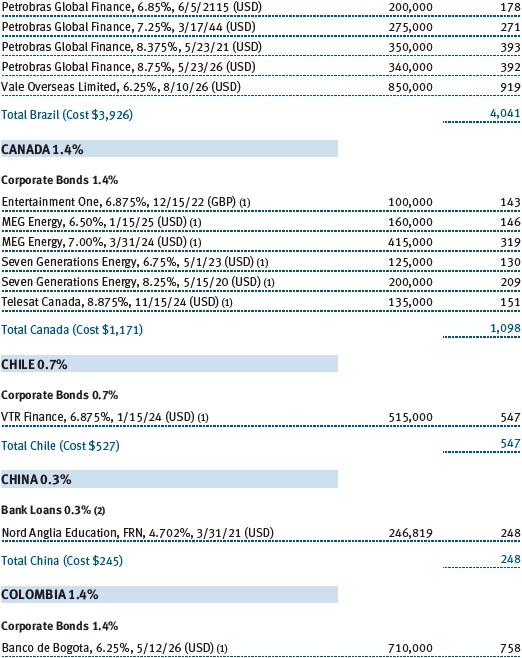
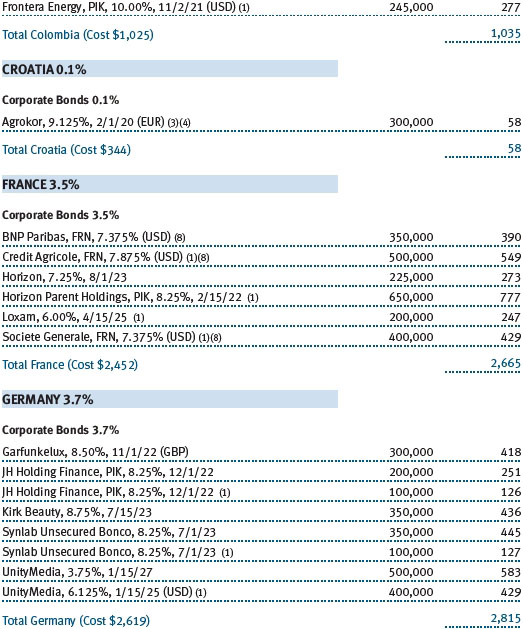



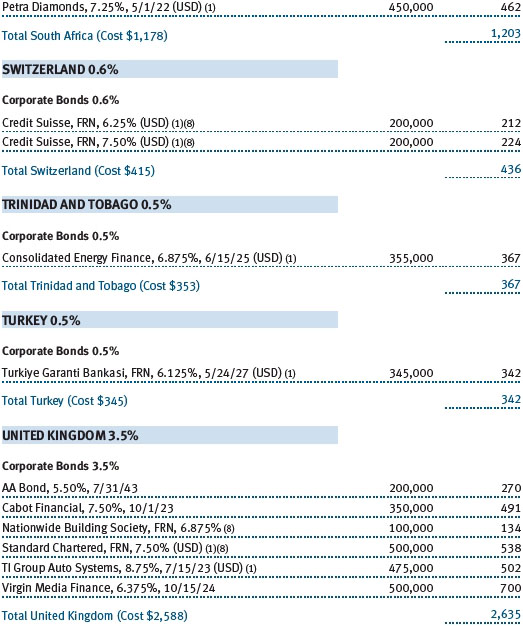

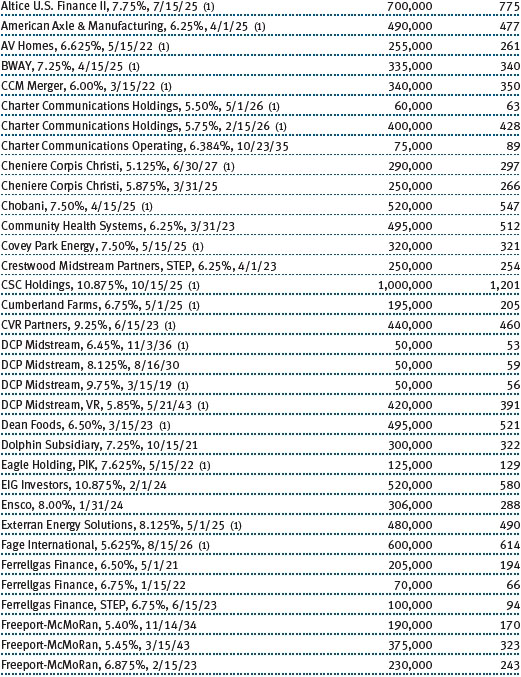
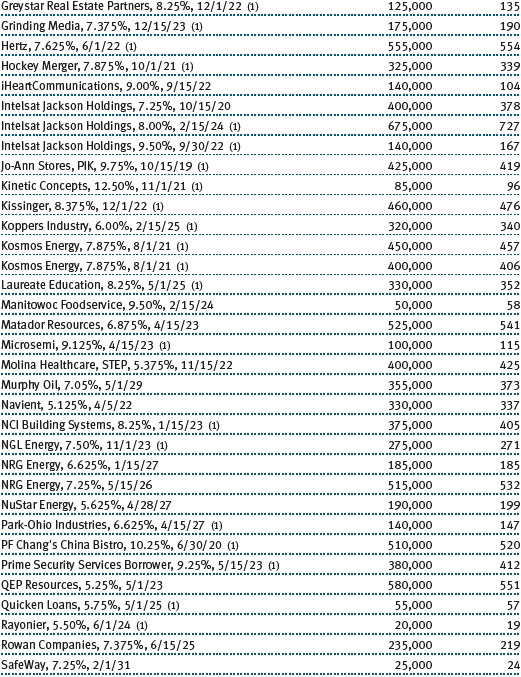


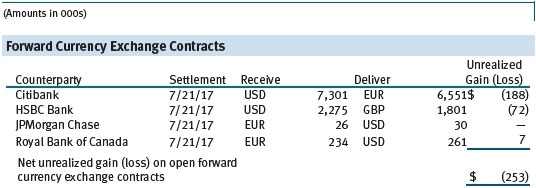

The accompanying notes are an integral part of these financial statements.
Unaudited


The accompanying notes are an integral part of these financial statements.
Unaudited
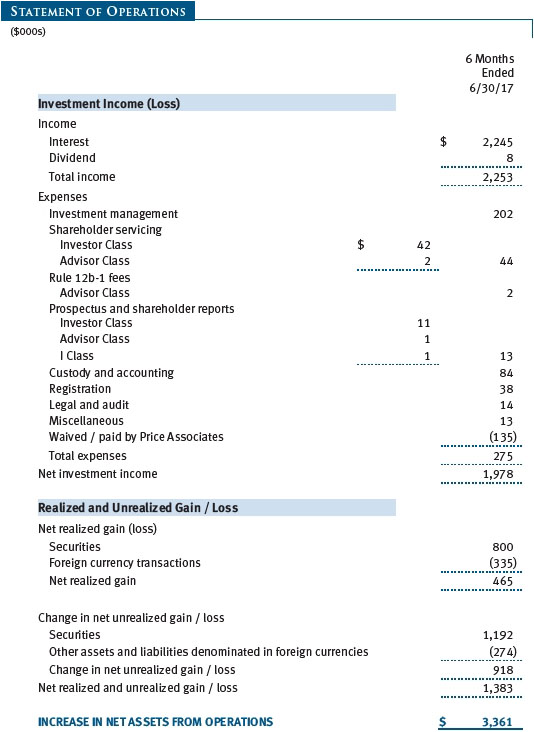
The accompanying notes are an integral part of these financial statements.
Unaudited
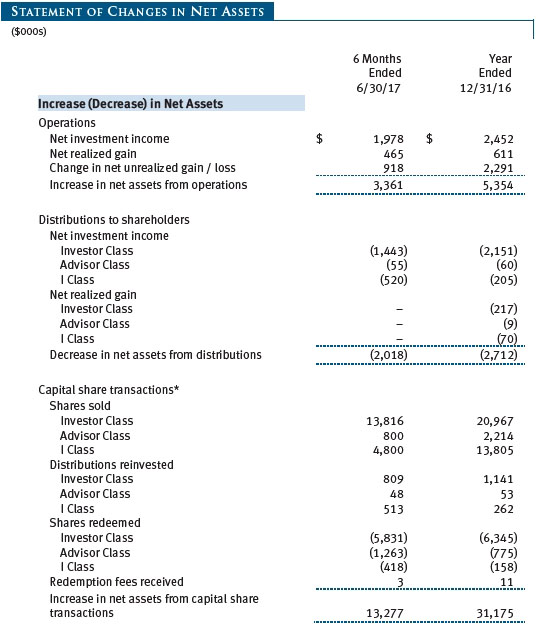

The accompanying notes are an integral part of these financial statements.
Unaudited
| Notes to Financial Statements |
T. Rowe Price International Funds, Inc. (the corporation) is registered under the Investment Company Act of 1940 (the 1940 Act). The Global High Income Bond Fund (the fund) is a diversified, open-end management investment company established by the corporation. The fund seeks high income and, secondary, capital appreciation. The fund has three classes of shares: the Global High Income Bond Fund (Investor Class), the Global High Income Bond Fund–Advisor Class (Advisor Class), and the Global High Income Bond Fund–I Class (I Class). Advisor Class shares are sold only through unaffiliated brokers and other unaffiliated financial intermediaries. I Class shares generally are available only to investors meeting a $1,000,000 minimum investment or certain other criteria. The Advisor Class operates under a Board-approved Rule 12b-1 plan pursuant to which the class compensates financial intermediaries for distribution, shareholder servicing, and/or certain administrative services; the Investor and I Classes do not pay Rule 12b-1 fees. Each class has exclusive voting rights on matters related solely to that class; separate voting rights on matters that relate to all classes; and, in all other respects, the same rights and obligations as the other classes.
NOTE 1 - SIGNIFICANT ACCOUNTING POLICIES
Basis of Preparation The fund is an investment company and follows accounting and reporting guidance in the Financial Accounting Standards Board (FASB) Accounting Standards Codification Topic 946 (ASC 946). The accompanying financial statements were prepared in accordance with accounting principles generally accepted in the United States of America (GAAP), including, but not limited to, ASC 946. GAAP requires the use of estimates made by management. Management believes that estimates and valuations are appropriate; however, actual results may differ from those estimates, and the valuations reflected in the accompanying financial statements may differ from the value ultimately realized upon sale or maturity.
Investment Transactions, Investment Income, and Distributions Income and expenses are recorded on the accrual basis. Premiums and discounts on debt securities are amortized for financial reporting purposes. Dividends received from mutual fund investments are reflected as dividend income; capital gain distributions are reflected as realized gain/loss. Dividend income and capital gain distributions are recorded on the ex-dividend date. Income tax-related interest and penalties, if incurred, would be recorded as income tax expense. Investment transactions are accounted for on the trade date. Realized gains and losses are reported on the identified cost basis. Income distributions are declared by each class daily and paid monthly. Distributions to shareholders are recorded on the ex dividend date. A capital gain distribution may also be declared and paid by the fund annually.
Currency Translation Assets, including investments, and liabilities denominated in foreign currencies are translated into U.S. dollar values each day at the prevailing exchange rate, using the mean of the bid and asked prices of such currencies against U.S. dollars as quoted by a major bank. Purchases and sales of securities, income, and expenses are translated into U.S. dollars at the prevailing exchange rate on the date of the transaction. The effect of changes in foreign currency exchange rates on realized and unrealized security gains and losses is reflected as a component of security gains and losses.
Class Accounting Shareholder servicing, prospectus, and shareholder report expenses incurred by each class are charged directly to the class to which they relate. Expenses common to all classes and investment income are allocated to the classes based upon the relative daily net assets of each class’s settled shares; realized and unrealized gains and losses are allocated based upon the relative daily net assets of each class’s outstanding shares. The Advisor Class pays Rule 12b-1 fees, in an amount not exceeding 0.25% of the class’s average daily net assets.
Redemption Fees A 2% fee is assessed on redemptions of fund shares held for 90 days or less to deter short-term trading and to protect the interests of long-term shareholders. Redemption fees are withheld from proceeds that shareholders receive from the sale or exchange of fund shares. The fees are paid to the fund and are recorded as an increase to paid-in capital. The fees may cause the redemption price per share to differ from the net asset value per share.
New Accounting Guidance In October 2016, the Securities and Exchange Commission (SEC) issued a new rule, Investment Company Reporting Modernization, which, among other provisions, amends Regulation S-X to require standardized, enhanced disclosures, particularly related to derivatives, in investment company financial statements. Compliance with the guidance is effective for financial statements related to periods ending on or after August 1, 2017; adoption will have no effect on the fund’s net assets or results of operations.
NOTE 2 - VALUATION
The fund’s financial instruments are valued and each class’s net asset value (NAV) per share is computed at the close of the New York Stock Exchange (NYSE), normally 4 p.m. ET, each day the NYSE is open for business. However, the NAV per share may be calculated at a time other than the normal close of the NYSE if trading on the NYSE is restricted, if the NYSE closes earlier, or as may be permitted by the SEC.
Fair Value The fund’s financial instruments are reported at fair value, which GAAP defines as the price that would be received to sell an asset or paid to transfer a liability in an orderly transaction between market participants at the measurement date. The T. Rowe Price Valuation Committee (the Valuation Committee) is an internal committee that has been delegated certain responsibilities by the fund’s Board of Directors (the Board) to ensure that financial instruments are appropriately priced at fair value in accordance with GAAP and the 1940 Act. Subject to oversight by the Board, the Valuation Committee develops and oversees pricing-related policies and procedures and approves all fair value determinations. Specifically, the Valuation Committee establishes procedures to value securities; determines pricing techniques, sources, and persons eligible to effect fair value pricing actions; oversees the selection, services, and performance of pricing vendors; oversees valuation-related business continuity practices; and provides guidance on internal controls and valuation-related matters. The Valuation Committee reports to the Board and has representation from legal, portfolio management and trading, operations, risk management, and the fund’s treasurer.
Various valuation techniques and inputs are used to determine the fair value of financial instruments. GAAP establishes the following fair value hierarchy that categorizes the inputs used to measure fair value:
Level 1 – quoted prices (unadjusted) in active markets for identical financial instruments that the fund can access at the reporting date
Level 2 – inputs other than Level 1 quoted prices that are observable, either directly or indirectly (including, but not limited to, quoted prices for similar financial instruments in active markets, quoted prices for identical or similar financial instruments in inactive markets, interest rates and yield curves, implied volatilities, and credit spreads)
Level 3 – unobservable inputs
Observable inputs are developed using market data, such as publicly available information about actual events or transactions, and reflect the assumptions that market participants would use to price the financial instrument. Unobservable inputs are those for which market data are not available and are developed using the best information available about the assumptions that market participants would use to price the financial instrument. GAAP requires valuation techniques to maximize the use of relevant observable inputs and minimize the use of unobservable inputs. When multiple inputs are used to derive fair value, the financial instrument is assigned to the level within the fair value hierarchy based on the lowest-level input that is significant to the fair value of the financial instrument. Input levels are not necessarily an indication of the risk or liquidity associated with financial instruments at that level but rather the degree of judgment used in determining those values.
Valuation Techniques Debt securities generally are traded in the over-the-counter (OTC) market. Securities with remaining maturities of one year or more at the time of acquisition are valued at prices furnished by dealers who make markets in such securities or by an independent pricing service, which considers the yield or price of bonds of comparable quality, coupon, maturity, and type, as well as prices quoted by dealers who make markets in such securities. Securities with remaining maturities of less than one year at the time of acquisition generally use amortized cost in local currency to approximate fair value. However, if amortized cost is deemed not to reflect fair value or the fund holds a significant amount of such securities with remaining maturities of more than 60 days, the securities are valued at prices furnished by dealers who make markets in such securities or by an independent pricing service. Generally, debt securities are categorized in Level 2 of the fair value hierarchy; however, to the extent the valuations include significant unobservable inputs, the securities would be categorized in Level 3.
Investments in mutual funds are valued at the mutual fund’s closing NAV per share on the day of valuation and are categorized in Level 1 of the fair value hierarchy. Forward currency exchange contracts are valued using the prevailing forward exchange rate and are categorized in Level 2 of the fair value hierarchy. Assets and liabilities other than financial instruments, including short-term receivables and payables, are carried at cost, or estimated realizable value, if less, which approximates fair value.
Thinly traded financial instruments and those for which the above valuation procedures are inappropriate or are deemed not to reflect fair value are stated at fair value as determined in good faith by the Valuation Committee. The objective of any fair value pricing determination is to arrive at a price that could reasonably be expected from a current sale. Financial instruments fair valued by the Valuation Committee are primarily private placements, restricted securities, warrants, rights, and other securities that are not publicly traded.
Subject to oversight by the Board, the Valuation Committee regularly makes good faith judgments to establish and adjust the fair valuations of certain securities as events occur and circumstances warrant. For instance, in determining the fair value of troubled or thinly traded debt instruments, the Valuation Committee considers a variety of factors, which may include, but are not limited to, the issuer’s business prospects, its financial standing and performance, recent investment transactions in the issuer, strategic events affecting the company, market liquidity for the issuer, and general economic conditions and events. In consultation with the investment and pricing teams, the Valuation Committee will determine an appropriate valuation technique based on available information, which may include both observable and unobservable inputs. The Valuation Committee typically will afford greatest weight to actual prices in arm’s length transactions, to the extent they represent orderly transactions between market participants, transaction information can be reliably obtained, and prices are deemed representative of fair value. However, the Valuation Committee may also consider other valuation methods such as a discount or premium from market value of a similar, freely traded security of the same issuer; discounted cash flows; yield to maturity; or some combination. Fair value determinations are reviewed on a regular basis and updated as information becomes available, including actual purchase and sale transactions of the issue. Because any fair value determination involves a significant amount of judgment, there is a degree of subjectivity inherent in such pricing decisions, and fair value prices determined by the Valuation Committee could differ from those of other market participants. Depending on the relative significance of unobservable inputs, including the valuation technique(s) used, fair valued securities may be categorized in Level 2 or 3 of the fair value hierarchy.
Valuation Inputs The following table summarizes the fund’s financial instruments, based on the inputs used to determine their fair values on June 30, 2017:
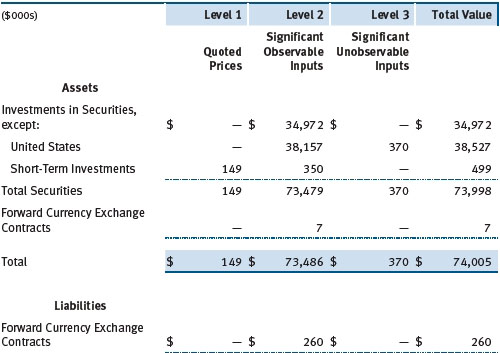
There were no material transfers between Levels 1 and 2 during the six months ended June 30, 2017.
Following is a reconciliation of the fund’s Level 3 holdings for the six months ended June 30, 2017. Gain (loss) reflects both realized and change in unrealized gain/loss on Level 3 holdings during the period, if any, and is included on the accompanying Statement of Operations. The change in unrealized gain/loss on Level 3 instruments held at June 30, 2017, totaled $(3,000) for the six months ended June 30, 2017.

NOTE 3 - DERIVATIVE INSTRUMENTS
During the six months ended June 30, 2017, the fund invested in derivative instruments. As defined by GAAP, a derivative is a financial instrument whose value is derived from an underlying security price, foreign exchange rate, interest rate, index of prices or rates, or other variable; it requires little or no initial investment and permits or requires net settlement. The fund invests in derivatives only if the expected risks and rewards are consistent with its investment objectives, policies, and overall risk profile, as described in its prospectus and Statement of Additional Information. The fund may use derivatives for a variety of purposes, such as seeking to hedge against declines in principal value, increase yield, invest in an asset with greater efficiency and at a lower cost than is possible through direct investment, or to adjust portfolio duration and credit exposure. The risks associated with the use of derivatives are different from, and potentially much greater than, the risks associated with investing directly in the instruments on which the derivatives are based. The fund at all times maintains sufficient cash reserves, liquid assets, or other SEC-permitted asset types to cover its settlement obligations under open derivative contracts.
The fund values its derivatives at fair value and recognizes changes in fair value currently in its results of operations. Accordingly, the fund does not follow hedge accounting, even for derivatives employed as economic hedges. Generally, the fund accounts for its derivatives on a gross basis. It does not offset the fair value of derivative liabilities against the fair value of derivative assets on its financial statements, nor does it offset the fair value of derivative instruments against the right to reclaim or obligation to return collateral. As of June 30, 2107, the fund held foreign exchange derivatives with a fair value of $7,000, included in Unrealized gain on foreign currency exchange contracts, and $260,000, included in Unrealized loss on forward currency exchange contracts, on the accompanying Statement of Assets and Liabilities.
Additionally, during the six months ended June 30, 2017, the fund recognized $344,000 of realized loss on Foreign Currency Transactions and a $(288,000) change in unrealized gain/loss on Foreign Currency Transactions related to its investments in foreign exchange derivatives; such amounts are included on the accompanying Statement of Operations.
Counterparty Risk and Collateral The fund invests in derivatives, such as bilateral swaps, forward currency exchange contracts, or OTC options, that are transacted and settle directly with a counterparty (bilateral derivatives), and thereby expose the fund to counterparty risk. To mitigate this risk, the fund has entered into master netting arrangements (MNAs) with certain counterparties that permit net settlement under specified conditions and, for certain counterparties, also require the exchange of collateral to cover mark-to-market exposure. MNAs may be in the form of International Swaps and Derivatives Association master agreements (ISDAs) or foreign exchange letter agreements (FX letters).
MNAs govern the ability to offset amounts the fund owes a counterparty against amounts the counterparty owes the fund (net settlement). Both ISDAs and FX letters generally allow termination of transactions and net settlement upon the occurrence of contractually specified events, such as failure to pay or bankruptcy. In addition, ISDAs specify other events, the occurrence of which would allow one of the parties to terminate. For example, a downgrade in credit rating of a counterparty would allow the fund to terminate while a decline in the fund’s net assets of more than a specified percentage would allow the counterparty to terminate. Upon termination, all transactions with that counterparty would be liquidated and a net termination amount determined. ISDAs include collateral agreements whereas FX letters do not. Collateral requirements are determined daily based on the net aggregate unrealized gain or loss on all bilateral derivatives with each counterparty, subject to minimum transfer amounts that typically range from $100,000 to $250,000. Any additional collateral required due to changes in security values is typically transferred the same business day.
Collateral may be in the form of cash or debt securities issued by the U.S. government or related agencies. Cash posted by the fund is reflected as cash deposits in the accompanying financial statements and generally is restricted from withdrawal by the fund; securities posted by the fund are so noted in the accompanying Portfolio of Investments; both remain in the fund’s assets. Collateral pledged by counterparties is not included in the fund’s assets because the fund does not obtain effective control over those assets. For bilateral derivatives, collateral posted or received by the fund is held in a segregated account at the fund’s custodian. As of June 30, 2017, no collateral was pledged by either the fund or counterparties for bilateral derivatives.
Forward Currency Exchange Contracts The fund is subject to foreign currency exchange rate risk in the normal course of pursuing its investment objectives. It uses forward currency exchange contracts (forwards) primarily to protect its non-U.S. dollar-denominated securities from adverse currency movements and to gain exposure to currencies for the purposes of risk management or enhanced return. A forward involves an obligation to purchase or sell a fixed amount of a specific currency on a future date at a price set at the time of the contract. Although certain forwards may be settled by exchanging only the net gain or loss on the contract, most forwards are settled with the exchange of the underlying currencies in accordance with the specified terms. Forwards are valued at the unrealized gain or loss on the contract, which reflects the net amount the fund either is entitled to receive or obligated to deliver, as measured by the difference between the forward exchange rates at the date of entry into the contract and the forward rates at the reporting date. Appreciated forwards are reflected as assets and depreciated forwards are reflected as liabilities on the accompanying Statement of Assets and Liabilities. Risks related to the use of forwards include the possible failure of counterparties to meet the terms of the agreements; that anticipated currency movements will not occur, thereby reducing the fund’s total return; and the potential for losses in excess of the fund’s initial investment. During the six months ended June 30, 2017, the volume of the fund’s activity in forwards, based on underlying notional amounts, was generally between 12% and 17% of net assets.
NOTE 4 - OTHER INVESTMENT TRANSACTIONS
Consistent with its investment objective, the fund engages in the following practices to manage exposure to certain risks and/or to enhance performance. The investment objective, policies, program, and risk factors of the fund are described more fully in the fund’s prospectus and Statement of Additional Information.
Emerging and Frontier Markets The fund may invest, either directly or through investments in T. Rowe Price institutional funds, in securities of companies located in, issued by governments of, or denominated in or linked to the currencies of emerging and frontier market countries; at period-end, approximately 18% of the fund’s net assets were invested in emerging markets and 6% in frontier markets. Emerging markets, and to a greater extent frontier markets, generally have economic structures that are less diverse and mature, and political systems that are less stable, than developed countries. These markets may be subject to greater political, economic, and social uncertainty and differing regulatory environments that may potentially impact the fund’s ability to buy or sell certain securities or repatriate proceeds to U.S. dollars. Such securities are often subject to greater price volatility, less liquidity, and higher rates of inflation than U.S. securities. Investing in frontier markets is significantly riskier than investing in other countries, including emerging markets.
Noninvestment-Grade Debt At June 30, 2017, approximately 94% of the fund’s net assets were invested, either directly or through its investment in T. Rowe Price institutional funds, in noninvestment-grade debt, including “high yield” or “junk” bonds or leveraged loans. The noninvestment-grade debt market may experience sudden and sharp price swings due to a variety of factors, including changes in economic forecasts, stock market activity, large sustained sales by major investors, a high-profile default, or a change in market sentiment. These events may decrease the ability of issuers to make principal and interest payments and adversely affect the liquidity or value, or both, of such securities. Investments in noninvestment-grade holdings may be considered speculative.
Restricted Securities The fund may invest in securities that are subject to legal or contractual restrictions on resale. Prompt sale of such securities at an acceptable price may be difficult and may involve substantial delays and additional costs.
Bank Loans The fund may invest in bank loans, which represent an interest in amounts owed by a borrower to a syndicate of lenders. Bank loans are generally noninvestment grade and often involve borrowers whose financial condition is highly leveraged. Bank loans may be in the form of either assignments or participations. A loan assignment transfers all legal, beneficial, and economic rights to the buyer, and transfer typically requires consent of both the borrower and agent. In contrast, a loan participation generally entitles the buyer to receive the cash flows from principal, interest, and any fee payments on a portion of a loan; however, the seller continues to hold legal title to that portion of the loan. As a result, the buyer of a loan participation generally has no direct recourse against the borrower and is exposed to credit risk of both the borrower and seller of the participation. Bank loans often have extended settlement periods, usually may be repaid at any time at the option of the borrower, and may require additional principal to be funded at the borrowers’ discretion at a later date (unfunded commitments). Until settlement, the fund maintains liquid assets sufficient to settle its unfunded loan commitments. The fund reflects both the funded portion of a bank loan as well as its unfunded commitment in the Portfolio of Investments. However, if a credit agreement provides no initial funding of a tranche, and funding of the full commitment at a future date(s) is at the borrower’s discretion and considered uncertain, a loan is reflected in the Portfolio of Investments only if, and only to the extent that, the fund has actually settled a funding commitment.
Other Purchases and sales of portfolio securities other than short-term securities aggregated $47,713,000 and $33,883,000, respectively, for the six months ended June 30, 2017.
NOTE 5 - FEDERAL INCOME TAXES
No provision for federal income taxes is required since the fund intends to continue to qualify as a regulated investment company under Subchapter M of the Internal Revenue Code and distribute to shareholders all of its taxable income and gains. Distributions determined in accordance with federal income tax regulations may differ in amount or character from net investment income and realized gains for financial reporting purposes. Financial reporting records are adjusted for permanent book/tax differences to reflect tax character but are not adjusted for temporary differences. The amount and character of tax-basis distributions and composition of net assets are finalized at fiscal year-end; accordingly, tax-basis balances have not been determined as of the date of this report.
The fund intends to retain realized gains to the extent of available capital loss carryforwards. Net realized capital losses may be carried forward indefinitely to offset future realized capital gains. As of December 31, 2016, the fund had $612,000 of available capital loss carryforwards.
At June 30, 2017, the cost of investments for federal income tax purposes was $72,068,000. Net unrealized gain aggregated $1,685,000 at period-end, of which $2,562,000 related to appreciated investments and $877,000 related to depreciated investments.
NOTE 6 - RELATED PARTY TRANSACTIONS
The fund is managed by T. Rowe Price Associates, Inc. (Price Associates), a wholly owned subsidiary of T. Rowe Price Group, Inc. (Price Group). Price Associates has entered into a sub-advisory agreement(s) with one or more of its wholly owned subsidiaries, to provide investment advisory services to the fund. The investment management agreement between the fund and Price Associates provides for an annual investment management fee, which is computed daily and paid monthly. The fee consists of an individual fund fee, equal to 0.30% of the fund’s average daily net assets, and a group fee. The group fee rate is calculated based on the combined net assets of certain mutual funds sponsored by Price Associates (the group) applied to a graduated fee schedule, with rates ranging from 0.48% for the first $1 billion of assets to 0.265% for assets in excess of $650 billion. The fund’s group fee is determined by applying the group fee rate to the fund’s average daily net assets. At June 30, 2017, the effective annual group fee rate was 0.29%.
The Investor Class and Advisor Class are each subject to a contractual expense limitation through the limitation dates indicated in the table below. During the limitation period, Price Associates is required to waive its management fee or pay any expenses (excluding interest, expenses related to borrowings, taxes, brokerage, and other non-recurring expenses permitted by the investment management agreement) that would otherwise cause the class’s ratio of annualized total expenses to average net assets (expense ratio) to exceed its expense limitation. Each class is required to repay Price Associates for expenses previously waived/paid to the extent the class’s net assets grow or expenses decline sufficiently to allow repayment without causing the class’s expense ratio to exceed its expense limitation in effect at the time of the waiver. However, no repayment will be made more than three years after the date of a payment or waiver.

The I Class is also subject to an operating expense limitation (I Class limit) pursuant to which Price Associates is contractually required to pay all operating expenses of the I Class, excluding management fees, interest, expenses related to borrowings, taxes, brokerage, and other non-recurring expenses permitted by the investment management agreement, to the extent such operating expenses, on an annualized basis, exceed 0.05% of average net assets. This agreement will continue until April 30, 2018, and may be renewed, revised, or revoked only with approval of the fund’s Board. The I Class is required to repay Price Associates for expenses previously paid to the extent the class’s net assets grow or expenses decline sufficiently to allow repayment without causing the class’s operating expenses to exceed the I Class limit in effect at the time of the waiver. However, no repayment will be made more than three years after the date of a payment or waiver.
Pursuant to these agreements, $135,000 of expenses were waived/paid by Price Associates during the six months ended June 30, 2017. Including these amounts, expenses previously waived/paid by Price Associates in the amount of $735,000 remain subject to repayment by the fund at June 30, 2017.
In addition, the fund has entered into service agreements with Price Associates and a wholly owned subsidiary of Price Associates (collectively, Price). Price Associates provides certain accounting and administrative services to the fund. T. Rowe Price Services, Inc. provides shareholder and administrative services in its capacity as the fund’s transfer and dividend-disbursing agent. For the six months ended June 30, 2017, expenses incurred pursuant to these service agreements were $41,000 for Price Associates and $20,000 for T. Rowe Price Services, Inc. The total amount payable at period-end pursuant to these service agreements is reflected as Due to Affiliates in the accompanying financial statements.
The fund may invest in the T. Rowe Price Government Reserve Fund, the T. Rowe Price Treasury Reserve Fund, or the T. Rowe Price Short-Term Fund (collectively, the Price Reserve Funds), open-end management investment companies managed by Price Associates and considered affiliates of the fund. The Price Reserve Funds are offered as short-term investment options to mutual funds, trusts, and other accounts managed by Price Associates or its affiliates and are not available for direct purchase by members of the public. The Price Reserve Funds pay no investment management fees.
As of June 30, 2017, T. Rowe Price Group, Inc., or its wholly owned subsidiaries owned 1,475,000 shares of the Investor Class, representing 28% of the Investor Class’s net assets, 25,000 shares of the Advisor Class, representing 17% of the Advisor Class’s net assets, and 25,432 shares of the I Class, representing 1% of the I Class’s net assets.
The fund may participate in securities purchase and sale transactions with other funds or accounts advised by Price Associates (cross trades), in accordance with procedures adopted by the fund’s Board and Securities and Exchange Commission rules, which require, among other things, that such purchase and sale cross trades be effected at the independent current market price of the security. During the six months ended June 30, 2017, the fund had no purchases or sales cross trades with other funds or accounts advised by Price Associates.
| Information on Proxy Voting Policies, Procedures, and Records |
A description of the policies and procedures used by T. Rowe Price funds and portfolios to determine how to vote proxies relating to portfolio securities is available in each fund’s Statement of Additional Information. You may request this document by calling 1-800-225-5132 or by accessing the SEC’s website, sec.gov.
The description of our proxy voting policies and procedures is also available on our corporate website. To access it, please visit the following Web page:
https://www3.troweprice.com/usis/corporate/en/utility/policies.html
Scroll down to the section near the bottom of the page that says, “Proxy Voting Policies.” Click on the Proxy Voting Policies link in the shaded box.
Each fund’s most recent annual proxy voting record is available on our website and through the SEC’s website. To access it through T. Rowe Price, visit the website location shown above, and scroll down to the section near the bottom of the page that says, “Proxy Voting Records.” Click on the Proxy Voting Records link in the shaded box.
| How to Obtain Quarterly Portfolio Holdings |
The fund files a complete schedule of portfolio holdings with the Securities and Exchange Commission for the first and third quarters of each fiscal year on Form N-Q. The fund’s Form N-Q is available electronically on the SEC’s website (sec.gov); hard copies may be reviewed and copied at the SEC’s Public Reference Room, 100 F St. N.E., Washington, DC 20549. For more information on the Public Reference Room, call 1-800-SEC-0330.
| Approval
of Investment Management Agreement and Subadvisory Agreement |
Each year, the fund’s Board of Directors (Board) considers the continuation of the investment management agreement (Advisory Contract) between the fund and its investment advisor, T. Rowe Price Associates, Inc. (Advisor), as well as the continuation of the investment subadvisory agreement (Subadvisory Contract) that the Advisor has entered into with T. Rowe Price International Ltd (Subadvisor) on behalf of the fund. In that regard, at an in-person meeting held on March 6–7, 2017 (Meeting), the Board, including a majority of the fund’s independent directors, approved the continuation of the fund’s Advisory Contract and Subadvisory Contract. At the Meeting, the Board considered the factors and reached the conclusions described below relating to the selection of the Advisor and Subadvisor and the approval of the Advisory Contract and Subadvisory Contract. The independent directors were assisted in their evaluation of the Advisory Contract and Subadvisory Contract by independent legal counsel from whom they received separate legal advice and with whom they met separately.
In providing information to the Board, the Advisor was guided by a detailed set of requests for information submitted by independent legal counsel on behalf of the independent directors. In considering and approving the Advisory Contract and Subadvisory Contract, the Board considered the information it believed was relevant, including, but not limited to, the information discussed below. The Board considered not only the specific information presented in connection with the Meeting, but also the knowledge gained over time through interaction with the Advisor and Subadvisor about various topics. The Board meets regularly and, at each of its meetings, covers an extensive agenda of topics and materials and considers factors that are relevant to its annual consideration of the renewal of the T. Rowe Price funds’ advisory contracts, including performance and the services and support provided to the funds and their shareholders.
Services Provided by the Advisor and
Subadvisor
The Board considered the
nature, quality, and extent of the services provided to the fund by the Advisor
and Subadvisor. These services included, but were not limited to, directing the
fund’s investments in accordance with its investment program and the overall
management of the fund’s portfolio, as well as a variety of related activities
such as financial, investment operations, and administrative services;
compliance; maintaining the fund’s records and registrations; and shareholder
communications. The Board also reviewed the background and experience of the
Advisor’s and Subadvisor’s senior management teams and investment personnel
involved in the management of the fund, as well as the Advisor’s compliance
record. The Board concluded that it was satisfied with the nature, quality, and
extent of the services provided by the Advisor and Subadvisor.
Investment Performance of the Fund
The Board took into account discussions
with the Advisor and reports that it receives throughout the year relating to
fund performance. In connection with the Meeting, the Board reviewed the fund’s
net annualized total returns for the one-year period as of September 30, 2016,
and compared the returns with the performance of a peer group of funds with
similar investment programs and a wide variety of other previously agreed-upon
comparable performance measures and market data, including those supplied by
Broadridge, which is an independent provider of mutual fund data.
On the basis of this evaluation and the Board’s ongoing review of investment results, and factoring in the relative market conditions during certain of the performance periods, the Board concluded that the fund’s performance was satisfactory.
Costs, Benefits, Profits, and Economies
of Scale
The Board reviewed detailed
information regarding the revenues received by the Advisor under the Advisory
Contract and other benefits that the Advisor (and its affiliates, including the
Subadvisor) may have realized from its relationship with the fund, including any
research received under “soft dollar” agreements and commission-sharing
arrangements with broker-dealers. The Board considered that the Advisor and
Subadvisor may receive some benefit from soft-dollar arrangements pursuant to
which research is received from broker-dealers that execute the fund’s portfolio
transactions. The Board received information on the estimated costs incurred and
profits realized by the Advisor from managing the T. Rowe Price funds. While the
Board did not review information regarding profits realized from managing the
fund in particular because the fund had either not achieved sufficient portfolio
asset size or not recognized sufficient revenues to produce meaningful profit
margin percentages, the Board concluded that the Advisor’s profits were
reasonable in light of the services provided to the T. Rowe Price funds.
The Board also considered whether the fund benefits under the fee levels set forth in the Advisory Contract from any economies of scale realized by the Advisor. Under the Advisory Contract, the fund pays a fee to the Advisor for investment management services composed of two components—a group fee rate based on the combined average net assets of most of the T. Rowe Price funds (including the fund) that declines at certain asset levels and an individual fund fee rate based on the fund’s average daily net assets—and the fund pays its own expenses of operations (subject to expense limitations agreed to by the Advisor with respect to the fund’s Investor Class, Advisor Class, and I Class). At the Meeting, the Board approved an additional 0.005% breakpoint to the group fee schedule, effective May 1, 2017. With the new breakpoint, the group fee rate will decline to 0.265% when the combined average net assets of the applicable T. Rowe Price funds exceed $650 billion. Under the Subadvisory Contract, the Advisor may pay the Subadvisor up to 60% of the advisory fee that the Advisor receives from the fund. The Board concluded that the advisory fee structure for the fund continued to provide for a reasonable sharing of benefits from any economies of scale with the fund’s investors.
Fees and Expenses
The Board was provided with information regarding industry
trends in management fees and expenses. Among other things, the Board reviewed
data for peer groups that were compiled by Broadridge, which compared: (i)
contractual management fees, total expenses, actual management fees, and
non-management expenses of the Investor Class of the fund with a group of
competitor funds selected by Broadridge (Investor Class Expense Group); (ii)
total expenses and actual management fees of the Advisor Class of the fund with
a group of competitor funds selected by Broadridge (Advisor Class Expense
Group); and (iii) total expenses, actual management fees, and non-management
expenses of the Investor Class of the fund with a broader set of funds within
the Lipper investment classification (Expense Universe). The Board considered
the fund’s contractual management fee rate, actual management fee rate (which
reflects the management fees actually received from the fund by the Advisor
after any applicable waivers, reductions, or reimbursements), operating
expenses, and total expenses (which reflect the net total expense ratio of the
fund after any waivers, reductions, or reimbursements) in comparison with the
information for the Broadridge peer groups. Broadridge generally constructed the
peer groups by seeking the most comparable funds based on similar investment
classifications and objectives, expense structure, asset size, and operating
components and attributes and ranked funds into quintiles, with the first
quintile representing the funds with the lowest relative expenses and the fifth
quintile representing the funds with the highest relative expenses. The
information provided to the Board indicated that the fund’s contractual
management fee ranked in the third quintile (Investor Class Expense Group); the
fund’s actual management fee rate ranked in the first quintile (Investor Class
Expense Group, Advisor Class Expense Group, and Expense Universe); and the
fund’s total expenses ranked in the third quintile (Investor Class Expense
Group), first quintile (Advisor Class Expense Group), and third and fourth
quintiles (Expense Universe).
The Board also reviewed the fee schedules for institutional accounts and private accounts with similar mandates that are advised or subadvised by the Advisor and its affiliates. Management provided the Board with information about the Advisor’s responsibilities and services provided to subadvisory and other institutional account clients, including information about how the requirements and economics of the institutional business are fundamentally different from those of the mutual fund business. The Board considered information showing that the Advisor’s mutual fund business is generally more complex from a business and compliance perspective than its institutional account business and considered various relevant factors, such as the broader scope of operations and oversight, more extensive shareholder communication infrastructure, greater asset flows, heightened business risks, and differences in applicable laws and regulations associated with the Advisor’s proprietary mutual fund business. In assessing the reasonableness of the fund’s management fee rate, the Board considered the differences in the nature of the services required for the Advisor to manage its mutual fund business versus managing a discrete pool of assets as a subadvisor to another institution’s mutual fund or for an institutional account and that the Advisor generally performs significant additional services and assumes greater risk in managing the fund and other T. Rowe Price funds than it does for institutional account clients.
On the basis of the information provided and the factors considered, the Board concluded that the fees paid by the fund under the Advisory Contract are reasonable.
Approval of the Advisory Contract and
Subadvisory Contract
As noted, the Board
approved the continuation of the Advisory Contract and Subadvisory Contract. No
single factor was considered in isolation or to be determinative to the
decision. Rather, the Board concluded, in light of a weighting and balancing of
all factors considered, that it was in the best interests of the fund and its
shareholders for the Board to approve the continuation of the Advisory Contract
and Subadvisory Contract (including the fees to be charged for services
thereunder).
Item 2. Code of Ethics.
A code of ethics, as defined in Item 2 of Form N-CSR, applicable to its principal executive officer, principal financial officer, principal accounting officer or controller, or persons performing similar functions is filed as an exhibit to the registrant’s annual Form N-CSR. No substantive amendments were approved or waivers were granted to this code of ethics during the registrant’s most recent fiscal half-year.
Item 3. Audit Committee Financial Expert.
Disclosure required in registrant’s annual Form N-CSR.
Item 4. Principal Accountant Fees and Services.
Disclosure required in registrant’s annual Form N-CSR.
Item 5. Audit Committee of Listed Registrants.
Not applicable.
Item 6. Investments.
(a) Not applicable. The complete schedule of investments is included in Item 1 of this Form N-CSR.
(b) Not applicable.
Item 7. Disclosure of Proxy Voting Policies and Procedures for Closed-End Management Investment Companies.
Not applicable.
Item 8. Portfolio Managers of Closed-End Management Investment Companies.
Not applicable.
Item 9. Purchases of Equity Securities by Closed-End Management Investment Company and Affiliated Purchasers.
Not applicable.
Item 10. Submission of Matters to a Vote of Security Holders.
Not applicable.
Item 11. Controls and Procedures.
(a) The registrant’s principal executive officer and principal financial officer have evaluated the registrant’s disclosure controls and procedures within 90 days of this filing and have concluded that the registrant’s disclosure controls and procedures were effective, as of that date, in ensuring that information required to be disclosed by the registrant in this Form N-CSR was recorded, processed, summarized, and reported timely.
(b) The registrant’s principal executive officer and principal financial officer are aware of no change in the registrant’s internal control over financial reporting that occurred during the registrant’s second fiscal quarter covered by this report that has materially affected, or is reasonably likely to materially affect, the registrant’s internal control over financial reporting.
Item 12. Exhibits.
(a)(1) The registrant’s code of ethics pursuant to Item 2 of Form N-CSR is filed with the registrant’s annual Form N-CSR.
(2) Separate certifications by the registrant's principal executive officer and principal financial officer, pursuant to Section 302 of the Sarbanes-Oxley Act of 2002 and required by Rule 30a-2(a) under the Investment Company Act of 1940, are attached.
(3) Written solicitation to repurchase securities issued by closed-end companies: not applicable.
(b) A certification by the registrant's principal executive officer and principal financial officer, pursuant to Section 906 of the Sarbanes-Oxley Act of 2002 and required by Rule 30a-2(b) under the Investment Company Act of 1940, is attached.
SIGNATURES
Pursuant to the requirements of the Securities Exchange Act of 1934 and the Investment Company Act of 1940, the registrant has duly caused this report to be signed on its behalf by the undersigned, thereunto duly authorized.
T. Rowe Price International Funds, Inc.
| By | /s/ Edward C. Bernard | |||||
| Edward C. Bernard | ||||||
| Principal Executive Officer | ||||||
| Date | August 21, 2017 | |||||
Pursuant to the requirements of the Securities Exchange Act of 1934 and the Investment Company Act of 1940, this report has been signed below by the following persons on behalf of the registrant and in the capacities and on the dates indicated.
| By | /s/ Edward C. Bernard | |||||
| Edward C. Bernard | ||||||
| Principal Executive Officer | ||||||
| Date | August 21, 2017 | |||||
| By | /s/ Catherine D. Mathews | |||||
| Catherine D. Mathews | ||||||
| Principal Financial Officer | ||||||
| Date | August 21, 2017 | |||||